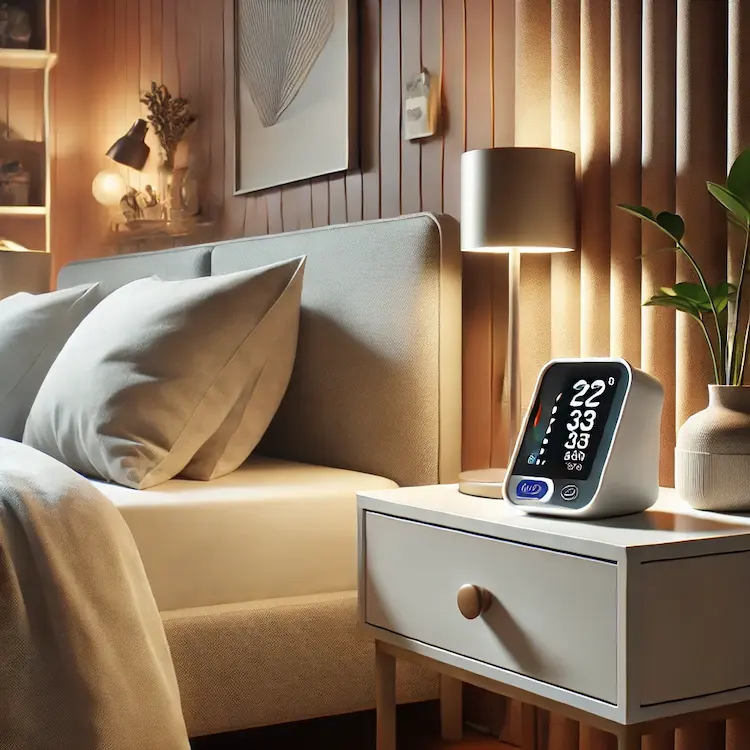Nocturnal hypertension, or elevated blood pressure during sleep, is a lesser-known but critical health condition that significantly affects long-term well-being. Unlike daytime hypertension, which is more commonly diagnosed, nocturnal hypertension often goes unnoticed. Yet, it is strongly associated with severe health outcomes, including heart disease, kidney failure, and even early mortality.
This article delves into the specifics of nocturnal hypertension, its causes, diagnosis, and management, equipping you with the knowledge to recognize and address this silent threat effectively.
What is Nocturnal Hypertension?
Nocturnal hypertension refers to high blood pressure that persists or worsens during sleep. In healthy individuals, blood pressure typically drops by 10–20% at night, a phenomenon called “nocturnal dipping.” This reduction allows the cardiovascular system to rest and recover. However, for individuals with nocturnal hypertension, this natural dip is absent or reversed, leading to increased strain on the heart and blood vessels.
Types of Nocturnal Blood Pressure Patterns:
- Dipper: A normal decrease in BP (10–20%) during sleep.
- Non-dipper: A reduction of less than 10%.
- Riser (Reverse Dipper): Blood pressure increases during sleep, posing the highest cardiovascular risk.
- Extreme Dipper: A drop of more than 20%, which may also indicate health risks such as reduced blood flow to vital organs.
Why Is Nocturnal Hypertension Important?
While daytime hypertension is widely recognized as a risk factor for cardiovascular diseases, nocturnal hypertension often remains undiagnosed and untreated. Its significance lies in its strong correlation with adverse health outcomes:
Health Impacts:
- Cardiovascular Diseases: Nocturnal hypertension increases the risk of heart attacks, strokes, and sudden cardiac death.
- Kidney Damage: Persistently high nighttime BP accelerates kidney damage and can lead to chronic kidney disease.
- Cognitive Decline: Studies suggest that elevated nighttime BP contributes to vascular dementia and other cognitive disorders.
- Sleep Disorders: Conditions like sleep apnea are closely linked to nocturnal hypertension, creating a vicious cycle of poor sleep and worsening health.
Societal Impacts:
- Increased Healthcare Costs: Patients with nocturnal hypertension are more likely to require frequent hospitalizations and long-term treatment.
- Reduced Productivity: Poor sleep and fatigue caused by nocturnal hypertension can lead to decreased work efficiency and quality of life.
Nocturnal Hypertension Causes and Risk Factors
Several factors contribute to nocturnal hypertension, including:
- Primary Hypertension: Chronic high blood pressure can manifest more prominently during sleep.
- Sleep Disorders: Obstructive sleep apnea (OSA) is a leading cause of nocturnal hypertension, as it disrupts normal breathing and blood pressure regulation.
- Lifestyle Factors: Poor diet, high salt intake, lack of exercise, and excessive alcohol consumption increase the risk.
- Underlying Health Conditions: Diabetes, chronic kidney disease, and hormonal imbalances can exacerbate nocturnal hypertension.
- Stress and Circadian Rhythm Disruptions: Irregular sleep patterns or chronic stress may lead to abnormal blood pressure fluctuations.
How Is Nocturnal Hypertension Diagnosed?
Diagnosing nocturnal hypertension requires specialized methods that go beyond standard in-clinic blood pressure readings:
1. Ambulatory Blood Pressure Monitoring (ABPM):
- A small, wearable device records blood pressure continuously for 24 hours, capturing both daytime and nighttime readings.
- Advantages: Highly accurate and provides a comprehensive BP profile.
- Disadvantages: Expensive and may cause mild discomfort.
2. Home Blood Pressure Monitoring:
- Portable monitors allow individuals to track their BP at night.
- Advantages: Affordable and accessible for regular use.
- Disadvantages: Limited precision compared to ABPM.

3. Clinical Blood Pressure Measurement:
- Performed during visits to healthcare providers.
- Limitations: Does not capture nighttime BP patterns, making it inadequate for diagnosing nocturnal hypertension.
Comparison of Diagnostic Methods:
| Method | Accuracy | Cost | Convenience | Ideal Use |
|---|---|---|---|---|
| Ambulatory BP Monitoring | High | High | Moderate | Comprehensive diagnosis |
| Home BP Monitoring | Moderate | Low | High | Routine screening |
| Clinical BP Measurement | Low | Low | High | Initial assessment only |
Managing Nocturnal Hypertension
Effective management of nocturnal hypertension involves a combination of lifestyle modifications, medical treatments, and monitoring tools.
1. Lifestyle Modifications:
- Dietary Changes: Follow the DASH diet, which emphasizes fruits, vegetables, lean proteins, and low sodium.
- Exercise: Regular aerobic activities such as walking, jogging, or swimming help regulate BP.
- Sleep Hygiene: Maintain a consistent sleep schedule, avoid caffeine or alcohol before bedtime, and create a relaxing bedtime routine.
2. Medications:
- Antihypertensives: Medications such as ACE inhibitors, ARBs, or calcium channel blockers are often prescribed.
- Bedtime Dosing: Taking medications in the evening may help target nighttime BP.
3. Monitoring and Technology:
- Wearable Devices: Advanced wearables track blood pressure trends throughout the day and night.
- Apps: Mobile apps integrated with BP monitors provide detailed insights and reminders.
Practical Tips for Managing Nocturnal Hypertension
- Monitor your blood pressure regularly, especially if you have risk factors.
- Prioritize sleep quality by addressing conditions like sleep apnea.
- Consult with a healthcare provider to adjust medication timing if needed.
- Adopt a heart-healthy lifestyle to mitigate risks.
Key Statistics
- Up to 30% of hypertensive individuals experience nocturnal hypertension.
- A riser pattern increases cardiovascular mortality risk by 80%.
- Over 50% of NH cases go undiagnosed without ABPM.
Conclusion
Nocturnal hypertension is a silent yet critical condition with far-reaching health implications. By recognizing the symptoms, understanding the risk factors, and leveraging advanced diagnostic tools, individuals can take proactive steps to manage their nighttime blood pressure. Early detection, lifestyle changes, and appropriate medical intervention can significantly reduce the risks associated with this condition.


